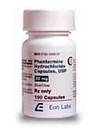|
cr dose paxil Aroxetine is bound to plasma protein at 100 ng mL and 400 ng mL cr dose paxil, respectively. Under clinical conditions cr dose paxil, paroxetine concentrations would normally be less than 400 ng mL. Paroxetine does not alter the in vitro protein binding of phenytoin or warfarin. Metabolism and Excretion: The mean elimination half-life of paroxetine was 15 to 20 hours throughout a range of single doses of PAXIL CR (12.5 mg cr dose paxil, 25 mg cr dose paxil, 37.5 mg cr dose paxil, and 50 mg). During repeated administration of PAXIL CR (25 mg once daily) cr dose paxil, steady state was reached within 2 weeks (i.e. cr dose paxil, comparable to immediate-release formulations). In a repeat-dose study in which normal male and female subjects (n = 23) received cr dose paxil.
cr dose paxil PAXIL CR (25 mg daily) cr dose paxil, mean steady state Cmax cr dose paxil, Cmin cr dose paxil, and AUC0-24 values were 30 ng mL cr dose paxil, 20 ng mL cr dose paxil, and 550 ng& 183; hr. mL cr dose paxil, respectively. Based on studies using immediate-release formulations cr dose paxil, steady-state drug exposure based on AUC0-24 was several-fold greater than would have been predicted from single-dose data. The excess accumulation is a consequence of the fact that 1 of the enzymes that metabolizes paroxetine is readily saturable. In steady-state dose proportionality studies involving elderly and nonelderly patients cr dose paxil, at doses of the immediate-release formulation of 20 mg to 40 mg daily for the elderly and 20 mg to 50 mg daily for the nonelderly cr dose paxil, some nonlinearity was observed in both populations cr dose paxil, again reflecting a saturable metabolic pathway. In comparison to Cmin values after 20 mg daily cr dose paxil, values after 40 mg daily were only about 2 to 3 times greater than doubled. Paroxetine is extensively metabolized after oral administration. The principal metabolites are polar and conjugated products of oxidation and methylation cr dose paxil, which are readily cleared. Conjugates with glucuronic acid and sulfate predominate cr dose paxil, and major metabolites have been isolated and identified. Data indicate that the metabolites have no more than 1 50 the potency of the parent compound at inhibiting serotonin uptake. The metabolism of paroxetine .
cr dose paxil Linearity was observed in both populations cr dose paxil, again reflecting a saturable metabolic pathway. In comparison to Cmin values after 20 mg daily cr dose paxil, values after 40 mg daily were only about 2 to 3 times greater than doubled. Paroxetine is extensively metabolized after oral administration. The principal metabolites are polar and conjugated products of oxidation and methylation cr dose paxil, which are readily cleared. Conjugates with glucuronic acid and sulfate predominate cr dose paxil, and major metabolites have been isolated and identified. Data indicate that the metabolites have no more than 1 50 the potency of the parent compound at inhibiting serotonin uptake. The metabolism of paroxetine i.
cr dose paxil 
cr dose paxil | | | | | |
cr dose paxil
|


